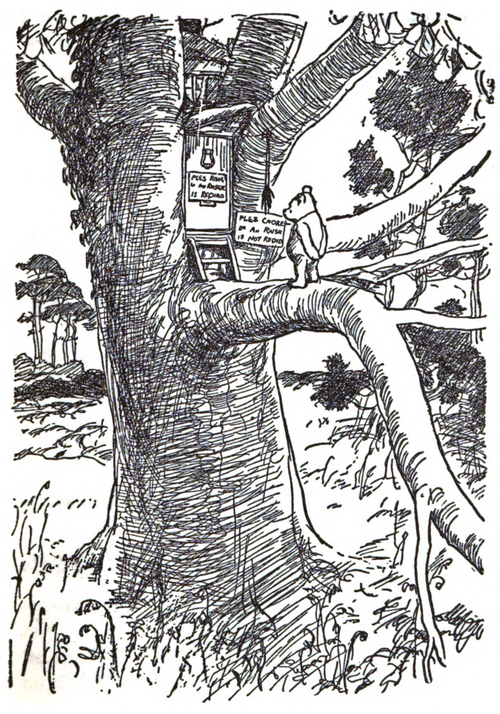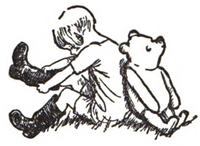Winnie-the-Pooh (1961)
Winnie-the-Pooh
Books for Boys and Girls
by A. A. Milne
with Decorations by Ernest H. Shepard
WINNIE-THE-POOH
THE WORLD OF CHRISTOPHER ROBIN
THE CHRISTOPHER ROBIN STORY BOOK
Song-Books from the Poems of a. a. milne
with Music by h. fraser-simon
THE POOH SONG BOOK
FOURTEEN SONGS FROM WHEN WE WERE VERY YOUNG
A. A. Milne
Winnie-the-Pooh
with decorations by
Ernest H. Shepard
E. P. Dutton
Publishers : New York
Winnie-the-Pooh
Copyright, 1926, by E. P. Dutton
Copyright Renewal, 1954, by A. A. Milne
All rights reserved.
Reprinted September 1961
in this completely new format
designed by Warren Chappell
Printed in the United States of America.
SBN 0-525-43035-0
To Her
Hand in hand we come
Christopher Robin and I
To lay this book in your lap.
Say you're surprised?
Say you like it?
Say it's just what you wanted?
Because it's yours—
because we love you.
Introduction
If you happen to have read another book about Christopher Robin, you may remember that he once had a swan (or the swan had Christopher Robin, I don't know which) and that he used to call this swan Pooh. That was a long time ago, and when we said good-bye, we took the name with us, as we didn't think the swan would want it any more. Well, when Edward Bear said that he would like an exciting name all to himself, Christopher Robin said at once, without stopping to think, that he was Winnie-the-Pooh. And he was. So, as I have explained the Pooh part, I will now explain the rest of it.
You can't be in London for long without going to the Zoo. There are some people who begin the Zoo at the beginning, called WAYIN, and walk as quickly as they can past every cage until they get to the one called WAYOUT, but the nicest people go straight to the animal they love the most, and stay there. So when Christopher Robin goes to the Zoo, he goes to where the Polar Bears are, and he whispers something to the third keeper from the left, and doors are unlocked, and we wander through dark passages and up steep stairs, until at last we come to the special cage, and the cage is opened, and out trots something brown and furry, and with a happy cry of "Oh, Bear!" Christopher Robin rushes into its arms. Now this bear's name is Winnie, which shows what a good name for bears it is, but the funny thing is that we can't remember whether Winnie is called after Pooh, or Pooh after Winnie. We did know once, but we have forgotten. . . .
I had written as far as this when Piglet looked up and said in his squeaky voice, "What about Me?" "My dear Piglet," I said, "the whole book is about you." "So it is about Pooh," he squeaked. You see what it is. He is jealous because he thinks Pooh is having a Grand Introduction all to himself. Pooh is the favourite, of course, there's no denying it, but Piglet comes in for a good many things which Pooh misses; because you can't take Pooh to school without everybody knowing it, but Piglet is so small that he slips into a pocket, where it is very comforting to feel him when you are not quite sure whether twice seven is twelve or twenty-two. Sometimes he slips out and has a good look in the ink-pot, and in this way he has got more education than Pooh, but Pooh doesn't mind. Some have brains, and some haven't, he says, and there it is.
And now all the others are saying, "What about Us?" So perhaps the best thing to do is to stop writing Introductions and get on with the book.
Contents
page I. In Which We Are Introduced To Winnie-the-Pooh And Some Bees, and the Stories Begin 3 II. In Which Pooh Goes Visiting and Gets Into a Tight Place 22 III. In Which Pooh and Piglet Go Hunting and Nearly Catch a Woozle 34 IV. In Which Eeyore Loses a Tail and Pooh Finds One 44 V. In Which Piglet Meets a Heffalump 56 VI. In Which Eeyore Has a Birthday and Gets Two Presents 72 VII. In Which Kanga and Baby Roo Come to the Forest, and Piglet Has a Bath 90 VIII. In Which Christopher Robin Leads an Expotition to the North Pole 110 IX. In Which Piglet Is Entirely Surrounded by Water 130 X. In Which Christopher Robin Gives Pooh a Party, and We Say Good-bye 147
![]()
This work is in the public domain in the United States because it was published in 1926, before the cutoff of January 1, 1929.
The longest-living author of this work died in 1956, so this work is in the public domain in countries and areas where the copyright term is the author's life plus 67 years or less. This work may be in the public domain in countries and areas with longer native copyright terms that apply the rule of the shorter term to foreign works.
![]()
Public domainPublic domainfalsefalse



